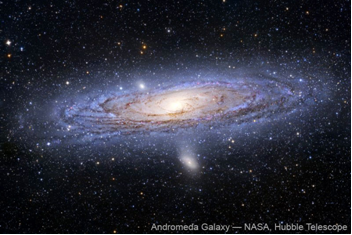- 1610: Galileo
- 1676: Ole Rømer
- 1687: Isaac Newton
- 1781: William Herschel
- 1838: Friedrich Bessel
- 1861: William and Margaret Huggins
- 1912: Henrietta Leavitt
- 1917 Einstein
- 1920: Harlow Shapley
- 1929 Edwin Hubble
- 1948: Ralph Alpher
- 1949: Fred Hoyle
- 1963: Maarten Schmidt
- 1964: Arno Penzias and Robert Wilson
- 1978: Vera Rubin and Kent Ford
- 1989: Margaret Geller and John Huchra
- 1992: John Mather and George Smoot
- 1995: Robert Williams
- 1998: Saul Perlmutter and Brian Schmidt
- 2010: Wendy Freedman
1781 Activity: Observing the Milky Way
 The image at right is the Andromeda Galaxy and two small satellite galaxies taken by the Hubble Space Telescope. Andromeda is our closest neighbor in galactic space. If there are any astronomers living in that galaxy who are looking at us with a similar instrument, our Milky Way galaxy would look very much like this.
The image at right is the Andromeda Galaxy and two small satellite galaxies taken by the Hubble Space Telescope. Andromeda is our closest neighbor in galactic space. If there are any astronomers living in that galaxy who are looking at us with a similar instrument, our Milky Way galaxy would look very much like this.
Imagine that you live on a planet orbiting a star within Andromeda’s disk. On a clear night you would see a band of light across the sky formed by the billions of stars within the disk. That is the way our own Milky Way appears from Earth on a clear evening, far away from city lights.
Few people today have seen the Milky Way because the vast majority of us live in cities. Even rural areas have malls and lighted roads. The next time you are going for an overnight hike, camping trip, or nighttime walk on the beach, take a pair of binoculars with you. If the sky is clear enough to show a faint band of light, use your binoculars to scan across the Milky Way, and see how many stars you can see. Try to envision Herschel’s effort to measure the distance to as many stars as possible, and his amazing ability to recognize that the faint band of light is really the disk of our home galaxy.